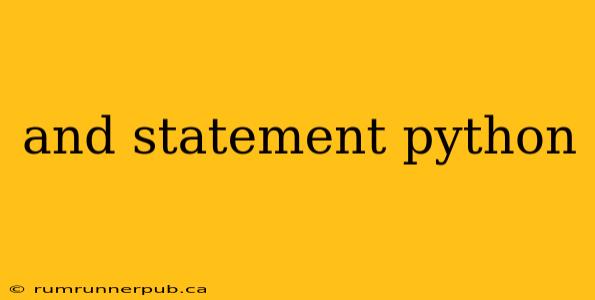The and statement in Python is a crucial logical operator used to combine multiple Boolean expressions. Understanding how it works is fundamental for writing effective and efficient Python code. This article will explore the and operator, drawing insights from Stack Overflow discussions to provide a comprehensive understanding and address common pitfalls.
Understanding the Basics
The and operator returns True only if both expressions on either side are True. Otherwise, it returns False. This is a crucial difference from the or operator, which returns True if at least one expression is True.
Truth Table:
| Expression A | Expression B | A and B |
|---|---|---|
| True | True | True |
| True | False | False |
| False | True | False |
| False | False | False |
Simple Example:
x = 10
y = 5
if x > 5 and y < 10:
print("Both conditions are true!")
else:
print("At least one condition is false.")
This code will print "Both conditions are true!" because both x > 5 and y < 10 evaluate to True.
Short-Circuiting: A Key Feature
Python's and operator exhibits short-circuiting behavior. This means that if the first expression evaluates to False, the second expression is not even evaluated. This can be crucial for efficiency and preventing errors.
Example illustrating short-circuiting:
def my_function():
print("Function called!")
return False
result = (5 < 0) and my_function() # my_function() is NOT called
print(f"Result: {result}") #Output: Result: False
result = (5 > 0) and my_function() # my_function() IS called
print(f"Result: {result}") #Output: Function called! Result: False
In the first case, since 5 < 0 is False, Python immediately knows the entire expression will be False and skips calling my_function(). In the second case, 5 > 0 is True, so my_function() is executed.
Addressing Common Stack Overflow Questions
Let's examine some common questions and answers from Stack Overflow regarding the Python and operator.
Question 1: "How can I use and with multiple conditions?"
Many Stack Overflow posts deal with chaining multiple conditions using and. You can simply chain as many conditions as needed:
age = 25
income = 60000
has_degree = True
if age > 21 and income > 50000 and has_degree:
print("Eligible for the loan.")
Question 2: "What's the difference between and and &?"
While both seem similar, and is a logical operator working on boolean values, whereas & is a bitwise operator. Using & on booleans will still work, but its behavior differs subtly. It performs a bitwise AND operation, treating True as 1 and False as 0. (Thanks to numerous Stack Overflow contributors for clarifying this distinction!)
print(True and True) # Output: True
print(True & True) # Output: True
print(True and False) # Output: False
print(True & False) #Output: 0 (integer 0, not boolean False)
Therefore it is best to stick to and for Boolean logic for clarity.
Conclusion
The Python and statement is a fundamental building block in conditional logic. Understanding its behavior, including short-circuiting, and distinguishing it from bitwise operators like & is crucial for writing clean, efficient, and error-free code. By incorporating insights from the vibrant Stack Overflow community, we've gained a deeper understanding of this essential operator. Remember to use and for logical operations on boolean values and avoid ambiguity by not mixing it with bitwise operations unless necessary.
